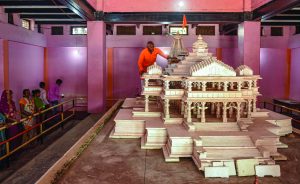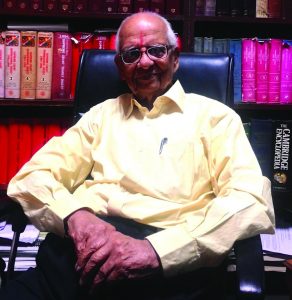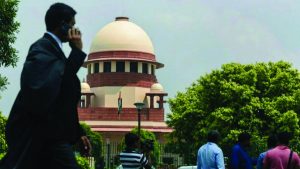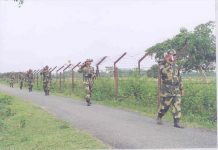 Like a last arm of his arsenal just three days before the poll schedule for the Delhi assembly, a visibly hurried prime minister Narendra Modi announced before the parliament about formation of independent trust — ‘Shri Ram Janmabhoomi Tirtha Kshetra Trust’ for the construction and management of a magnificent Ram temple in Ayodhya at the place of demolished Babri mosque. The government decision was overdue in view of Supreme Court
Like a last arm of his arsenal just three days before the poll schedule for the Delhi assembly, a visibly hurried prime minister Narendra Modi announced before the parliament about formation of independent trust — ‘Shri Ram Janmabhoomi Tirtha Kshetra Trust’ for the construction and management of a magnificent Ram temple in Ayodhya at the place of demolished Babri mosque. The government decision was overdue in view of Supreme Court
verdict delivered on 9November 2019 by constitution bench headed by Justice Ranjan Gogoi days before he demitted office of the chief justice of India.
PM Modi informed the House that the trust will take over the disputed 67.703 acres of land and has an inside and outside courtyard. He also informed that the Uttar Pradesh government has given its approval for 5 acres to be allotted to Sunni Waqf Board, as ordered by the Supreme Court.
The Uttar Pradesh government had agreed to give five-acres of land to the Sunni Waqf Board in Dhannipur village in Ayodhya on the Lucknow highway, about 18 kilometers from the district headquarters, almost 25 km away from the RamJanambhoomi complex. The wish of saints to keep the mosque outside the 14-Kosi area of Ayodhya looks to be foremost concern of the Yogi government.
With the formation of an independent trust, the government left no impediments in the way of resumption of construction of Sri Ram temple as it had stopped soon after stone laying on 9 November 1989 by the then Congress government. The political indulgence of the congress party in this event ruined its support base and led to political eclipse. Since then Congress has not seen the face of power in the state and its organisational strength eroded and suffered major setback.
After the announcement in parliament on February 5, 2020, the Ministry of Home affairsissueda gazette notification specifying all rights, title and interests in relation to the entire area acquiredby Union Government in Ayodhya after demolition including the inner and outer courtyard of the disputed site shall vest in the newly formed “Shri Ram Janmbhoomi Teerth Kshetra Trust.”
Surprisingly, the Trust got registered at the South Delhi residence of former Attorney Generaland senior advocate K. Parasaran who was a top law advisorof the then prime minister Rajiv Gandhi at the time of the foundation laying ceremony(‘Shilanyas’) held on November 9, 1989. Leaders of RSS and Vishwa Hindu Parishad (VHP) laid the foundation for a proposed Ram temple next to Babri Mosque in Ayodhya after Congress government had allowed it to perform it outside the disputed structure after securing written undertaking from VHP leaders.
Modi government has appointed 93 year old and most respected member of bar Mr K Parasaran as trustee to lead the Ram temple Trust who outstandingly argued on behalf of the deity Ram Lalla Virajman before the Supreme Court for the Hindu parties before the five-judge Constitution Bench in the Ayodhya title dispute. He appeared on behalf of Mahant Suresh Das, a defendant in a lawsuit filed by the Sunni Waqf Board and others in the Ram Janmabhoomi-Babri Masjid case. Soon after favourable verdict from the apex court,the two top leaders of the Rashtriya Swayamsevak Sangh (RSS) Mohan Bhagwat and Suresh Bhaiyyaji Joshi personally went to meet Mr Parasaran at his residence and thanked him for his contribution.
The government also nominated Kameshwar Chaupal, a Dalit leader from Bihar who was among the first to lay the foundation stone for Ram Mandir at Ayodhya on November 9, 1989, Jagatguru Madhavacharya Swami Vishwa Prasannatheertha, Pejawar math, Udupi, Jagatguru Shankaracharya Jyothishpeethadheeshwar Swami Vasudevanand Saraswati, Prayagraj, Uttar Pradesh, Yugpurush Paramanand
Maharaj, Haridwar, Swami Govinddev Giri Maharaj, Pune, Dinendra Das, Nirmohi Akhara, Ayodhya, Anil Mishra, homoeopathic doctor from Ayodhya, and Paramanand Maharaj from Haridwar are among the members. Bimlendra Mohan Pratap Mishra is included as a descendant of erstwhile rulers of Ayodhya in the newly formed Trust.
The government did not include prominent faces of seers, RSS or the VHP who led the temple movement over three decades that sparked resentment among the warriors of the movement. The BJP leadership is making all backdoor management to pacify these saints and VHP leaders.
The commissioner of Ayodhya, MP Agarwal, handed over charge as custodian of the Ram Janmabhoomi site to an erstwhile Ayodhya ruler and newly nominated trustee, Bimlendra Mohan Pratap Mishra. The Supreme Court had appointed the Faizabad commissioner as the official custodian of the site under disputeon October 24, 1994. He was responsible of security, maintaining status quo at the site and collecting money and other offerings by devotees at the makeshift temple.
The jubilant seers of Ayodhya want speedy construction of grand temple of Sri Ram and calculated coming Ram Navmi as best auspicious time to resume construction. A design and modelof Ram temple had displayed at Karsevak Puramin Ayodhya where the craving of sculptures and cutting of stone rock is continuing by artisans for more than last two decades.
Parasaran heads Ram Temple Trust
 Nonagenarian constitutional law expert and renowned Indian lawyer K Parasaran is most distinguished personality who comes from southern state of Tamil Nadu. He was awarded the Padma Bhushan in the year 2003 and Padma Vibhushan in the year 2011 for his outstanding contribution to the development of law in a judicious manner. Recognising his contribution in Ayodhya dispute, Modi government has appointed him to lead the Shri Ram Janmabhoomi Teerth Kshetra Trust. The trust will oversee the construction and management of Ram Temple in Ayodhya.
Nonagenarian constitutional law expert and renowned Indian lawyer K Parasaran is most distinguished personality who comes from southern state of Tamil Nadu. He was awarded the Padma Bhushan in the year 2003 and Padma Vibhushan in the year 2011 for his outstanding contribution to the development of law in a judicious manner. Recognising his contribution in Ayodhya dispute, Modi government has appointed him to lead the Shri Ram Janmabhoomi Teerth Kshetra Trust. The trust will oversee the construction and management of Ram Temple in Ayodhya.
Parasaran was Advocate General of Tamil Nadu during President’s rule in 1976. Prime Minister Indira Gandhi appointed him as Solicitor General of India and then top law officer, Attorney General of India. He continued on the post with Rajiv Gandhi until the end of his tenure. He was at the helm of affairs when priests and RSS-VHP leaders performed Shilanyas on November 9, 1989, in Ayodhya.
Parasaran began his legal practice before the Supreme Court in 1958. He defended the National Judicial Appointments Commission in 2014, as a member of the Rajya Sabha. In a career spanning over six decades, Parasaran is known for his contribution in many landmark cases, including Ayodhya and Sabarimala.
In Sabarimala matter, he also appeared for the Nair Service Society to defend the ban on the entry of menstruating women in the Aiyappa temple. However, the five-judge bench of the Supreme Court decided against his arguments and allowed the entry of women. Subsequently on his submissions, the apex court is reconsidering the matter in a larger bench.
He appeared before apex court to support Bacchawat Wage board recommendations for working journalists to insulate their freedom to express freely and fairly with independence of economic empowerment.
In June 2012, the president of India nominated him to the Rajya Sabha for a period of six years. During the NDA tenure of 1999-2004, former Prime Minister Atal Bihari Vajpayee appointed him as member of the drafting and editorial committee tasked with reviewing the working of the Constitution.
Born in Srirangam district of Tamil Nadu, Parasaran is the son of KesavaIyengar, a lawyer and Vedic scholar, and Shrimati Ranganayaki. He comes from a religious Hindu background. While pursuing his BL (now, BA. LLB), he was awarded the Shri Justice CV Kumaraswami Sastri Sanskrit Medal and Justice Shri V. BhashyamIyengar Gold Medal in Hindu Law. During the Bar Council examination, he received Justice KS Krishnaswamy Iyengar Medal. Parasaran has three sons. Mohan, Satish and Balaji, are also lawyers. Mohan Parasaran briefly served as Solicitor General in the UPA-2 regime. The family’s fourth generation has also joined the Bar.
Muslims unhappy over Masjid land allotment
 Muslims of Ayodhya town are unhappy over the allotment of five acres of land by the Uttar Pradesh government to the Sunni Waqf Board in Dhannipur village in Ayodhya on the Lucknow highway, about 18 kilometers from the district headquarters, almost 25 km away from the Ram Janambhoomi complex.
Muslims of Ayodhya town are unhappy over the allotment of five acres of land by the Uttar Pradesh government to the Sunni Waqf Board in Dhannipur village in Ayodhya on the Lucknow highway, about 18 kilometers from the district headquarters, almost 25 km away from the Ram Janambhoomi complex.
“The land provided to UP Sunni Central Waqf Board to build a mosque is not in Ayodhya. Merely renaming Faizabad district as Ayodhya does not mean that the land is at a prominent place in Ayodhya as mandated by the Supreme Court order on November 9 last year,” the convener of Babri Masjid Action Committee Zafaryab Jilani told Tehelka.
The UP government had renamed Faizabad district as Ayodhya during Diwali celebrations last year. “In all court documents part of the litigation all this while, Ayodhya was a small town of Faizabad. This Ayodhya cannot be equated to the newly created Ayodhya district by merely renaming a town and extending its municipal limits,” opined Jilani, adding that it does not mean the land offered is still in Ayodhya.”
“All Muslim organisations, including the All India Muslim Personal Law Board (AIMPLB), as also the Muslim community, has denounced accepting alternate land for Babri Masjid however, the land is being given to the Sunni Waqf Board,” he added.
Mr Jilani made it clear that AIMPLB will not challenge it in court but can definitely make this a part of the proposed curative petition against the judgement of apex court.
Uttar Pradesh Sunni Central Waqf Board maintained studied silence over the government decision to allocate five acres land to it for the construction of a mosque in lieu of Babri Masjid as per the terms of apex court orders. The chairperson of the Waqf Board, Zufar Faruqi, has gone abroad and the board may decide whether the land allotted to it is acceptable to board or not in its upcoming meeting on February 24.












